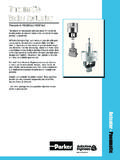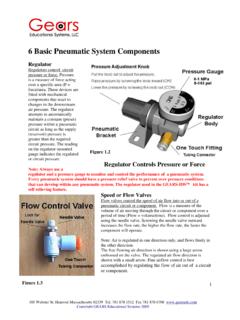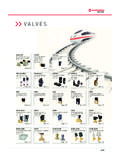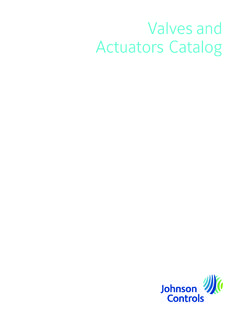Transcription of Hydraulic Systems Basics - Toro
1 Hydraulics Circuits, Components, Schematics, Hydrostatic Drives and Test Equipment PART NO. 09169SL This page is intentionally blank. Hydraulic Systems 1 Toro University Technical Training Table of Contents Circuits and Components .. 2 Schematics .. 11 Hydrostatic 18 Hydraulics Hoses and 25 Hydraulic 28 Testing Examples ..36 2 Hydraulic Systems Toro University Technical Training Hydraulic Circuits and Components This study guide will discuss basic Hydraulic Systems . We will look at fundamental principles and how they pertain to Hydraulic Systems . We will also learn about various Hydraulic components and their function. A Hydraulic circuit, whether it is simple or complex uses the basic Hydraulic principles discussed on the following pages.
2 A liquid can assume any shape and be bidirectional. Fluid is able to flow in any and all directions within a container. Pascal s Law Pascal s law states that when a confined fluid is placed under pressure, the pressure is transmitted equally in all directions and on all faces of the container. This is the principle used to extend the ram on a Hydraulic cylinder. By applying a force to move the piston on one end, the piston on the other end will move the same distance with same amount of force. Hydraulic Systems 3 Toro University Technical Training Hydraulic Leverage If we take the concept discussed on the previous slide and use containers or cylinders of different sizes, we can increase the mechanical advantage to lift a heavier load.
3 This is the principle that allows you to jack up a very heavy object while exerting a small amount of force on the handle of a Hydraulic jack. The animated illustration shows that 1 lb. of force exerted on a 1 sq. in. piston , moved 10 in. will lift 10 lbs. a distance of 1 in. with a 10 sq. in. piston . Click on the 'Play' button in the illustration to see a demonstration. The larger piston will move a shorter distance, but provides the mechanical advantage to lift a much heavier load. The mechanical workforce advantage in hydraulics can be thought of as leverage, but it is Hydraulic leverage. All Hydraulic circuits are essentially the same regardless of the application. There are four basic components required; a reservoir to hold the fluid; a pump to force the fluid through the system; valves to control the flow; and an actuator to convert the fluid energy into mechanical force to do the work.
4 Basic Hydraulic System Although Hydraulic circuit layouts may vary significantly in different applications, many of the components are similar in design or function. The principle behind most Hydraulic Systems is similar to that of the basic Hydraulic jack. Oil from the reservoir is drawn past a check ball into the piston type pump during the piston 's up-stroke. When the piston in the pump is pushed downward, oil will be directed past a second check ball into the cylinder. As the pump is actuated up and down, the incoming oil will cause the cylinder ram to extend. The lift cylinder will hold its extended position because the check ball is being seated by the pressure against it from the load side of the cylinder.
5 Because the pump displacement is usually much smaller than the cylinder, each stroke of the pump will move the cylinder a very small amount. If the cylinder is required to move at a faster rate, the surface area of the pump piston must be increased and/or the rate which the pump is actuated must be increased. Oil FLOW gives the cylinder ram its SPEED of movement and oil PRESSURE is the work force that lifts the load. 4 Hydraulic Systems Toro University Technical Training Reservoir Here is an example of a reservoir; one of the four basic requirements to make a Hydraulic system. This particular reservoir is made of molded plastic and is from a Greensmaster riding mower. Pump We can improve the efficiency and increase the versatility of a basic circuit by adding some more sophisticated components and changing the circuit layout.
6 By incorporating a gear pump in place of a hand piston pump, we increase oil flow to the cylinder which will increase the actuation rate of the ram. The image to the right shows a cutaway view of a three section gear pump. We can see the gear sets for all three sections and the input (drive) shaft. A gear pump is a positive displacement pump, meaning that whenever the pump is turning the pump must pump oil. If pump flow is totally blocked, sudden failure of the pump or other component will occur. As the gears in the pump rotate, suction is created at the inlet port of the pump. The fluid is drawn in to the pump and is carried in the spaces between the gear teeth to the discharge port of the pump.
7 At the discharge side of the pump the gear teeth mesh together and the oil is discharged from the pump. Click on the 'Play' button in the animated illustration to see the pump in operation. Note that the pump creates flow. The pump, by itself, does not create pressure. Pressure results only when there is resistance to flow. You cannot have pressure without flow (or potential flow). Hydraulic Systems 5 Toro University Technical Training Control Valve The flow from the pump to the cylinder is controlled by a sliding spool valve which can be actuated a hand or foot operated lever or an electric solenoid. The image to the right shows a cutaway of an actual Hydraulic control valve.
8 The valve shown in the illustration is a open center valve, meaning that the oil flow is returned to the reservoir when the valve is in the neutral position. The spool valve has the capability to direct fluid flow to either end of the actuator. As the spool is moved, fluid is redirected to one end or the other of the actuator, while fluid being pushed out the other end of the actuator is directed back to reservoir through the valve. This is that same spool valve, assembled with multiple sections to make a valve bank or assembly. This example is from a Greensmaster riding mower. In this example the valve bank would control all of the Hydraulic functions on the machine and would be actuated by foot or hand operated levers.
9 6 Hydraulic Systems Toro University Technical Training Basic Hydraulic System Here we have a spool valve in our simple Hydraulic system. You can see that the valve is in the neutral position and all the flow from the pump is directed back to the reservoir. If the spool is moved upward, the oil flow from the pump is directed through the spool to one end of the lift cylinder. The oil in the opposite end of the cylinder is pushed out as the ram extends, and will pass through the valve and return to the reservoir. Since the fluid from a positive displacement pump must flow continuously whenever the pump is running, it must have some where to go if not being used by the actuators.
10 If the load on the cylinder becomes too great or if the ram bottoms out, the flow from the pump will be directed past the relief valve returning to the reservoir. Lift Cylinder The flow diagram in the previous two illustrations shows the piston (barrel) end of the cylinder being pressurized to lift the load. Some lift circuits on Toro equipment pressurize the rod (ram) end of the cylinder to lift the load ( Reelmaster 5000 series). Hydraulic Systems 7 Toro University Technical Training Motor Substituting the lift cylinder with a gear motor, we can now utilize our basic circuit to create rotational movement to drive attachments. The adjacent photo shows a Hydraulic motor used to drive the reel on a cutting unit.









